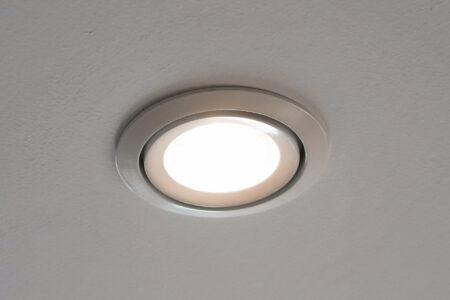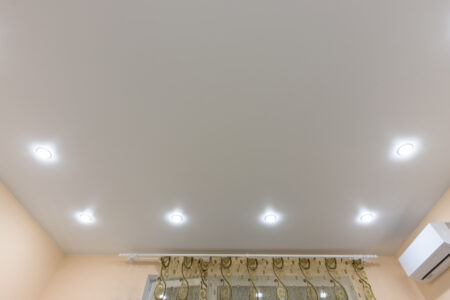The lighting inside your home influences the space’s ambiance, aesthetic, and functionality. You can choose from many types of indoor lighting that can make all the difference in design and ample illumination. Some lights provide ambient, task, or accent lighting, while others are simply decorative.
Whatever your lighting needs are, there is a type of light that serves that need best. These types of indoor lights will guide you to find the one that suits your bedroom, study, bathroom, kitchen, living room, dining room, and hallways. Some indoor lights can go anywhere while others only work in specific spaces.
Flush Mount Lights
Flush mount lights are named after the way the fixture sits flush with the ceiling with no gaps in between. You also get flush mount wall lights. Flush mount lights are known to produce wonderful ambient light, as the fixture usually has more than one bulb.

These fixtures are one of the oldest lighting styles and are known to work perfectly for low-hanging ceilings. A typical characteristic of a flush mount is that they have a light covering that looks like a bowl, but many styles are available to match any room design.
Different flush mount lighting styles:
- Bowl flush mount: The covering has a bowl shape.
- Drum flush light: The light cover has flattened sides.
- Dome flush mount: The covering has an opening at the bottom.
- Semi-flush mount: The base has a short rod-like expansion that separates the light fixture from the ceiling.
Where to use this lighting:
- Anywhere indoors
Pendant Lights
Pendant lights They get identified by a fixture that hangs from the roof on a cord, chain, or rod. The fixture part gets made from a wide variety of things, from glass to woven natural materials. Sizes also differ significantly.

Pendant lights offer the opportunity to make lighting a design element and often feature in kitchens and dining areas as a centerpiece. Due to the many styles available, pendant lights can fit any room and get used for any sort of lighting, especially task lighting. Using multiple pendant lights is a common design feature; using them in odd numbers is preferable for creating balance.
Where to use this lighting:
- Kitchen
- Dining room
- Living room
- Bedroom
- Study
Chandeliers
Chandeliers are a tasteful, elegant way to spice up your home’s indoor lighting. Chandeliers are decorative fixtures that suspend from the ceiling and are often quite large. The gorgeous light fixtures often have crystal glass beading that refracts light. More modern chandeliers don’t have glass prisms and use ornate metal designs.

This type of light isn’t the cheapest, but its splendor is well worth the price tag. Chandeliers are used as a statement piece and provide decent ambient light, making them a popular choice for homeowners with high ceilings.
Smaller, lower-ceiling areas like bedrooms can still benefit from the beauty of a chandelier, as you can buy a smaller one that is just as elegant.
Where to use this lighting:
- Living room
- Dining Room
- Staircase
- Bedroom
Recessed Lights
Thanks to their sleek appearance, recessed lights are among the most popular light choices. Recessed lights sit within the roof, keeping them hidden. These lights produce a potent amount of illumination and can fit any room design and roof height. With this indoor lighting option, you’ll need multiple recessed lights for even light distribution.

Recessed lights are available in many sizes and fulfill any lighting role, including ambient, task, and accent lighting. Depending on your needs and roof size, the recessed lights need specific dimensions, but the most common everyday lighting is 6 inches in diameter. It is common to use recessed lights in combination with other lighting types.
Where to use this lighting:
- Anywhere indoors, including beneath cabinets
Track Lights
Track lights are multiple fixtures secured to a track that contains electrical wires connecting the circuit. Track lights can be used almost anywhere in your home and offer bright, focused light. You can use track lighting on ceilings, walls, beams, or along joists.

Track lights work best if you want to highlight certain features like artwork or light washing an entire wall, but they can also be used for general lighting. The light fixture on the track light comes in many different styles. Some track lights are adjustable, so you can decide where you want to aim the light.
Standard track lights come in a straight line, but you also get other types, including:
- Swing arm: Some sections of the track are movable.
- Monorail: The track hangs from bars and comes in curved designs.
- Fixed track: Attaches to the wall and has adjustable fixtures.
Where to use this lighting:
- Living room
- Dining room
- Kitchen
- Bedroom
- Study
- Wall washing
Wall Sconces
Wall sconces are a lovely addition to your indoor space, especially for layered lighting. These wall-only fixtures can be decorative and functional and should be considered part of your lighting scheme. There are countless designs available, and you’re bound to find one that matches your style.

Wall sconces have a fixture extending outwards with a shade attached. Sconces can deliver light upwards, downwards, or both to match your lighting needs.
The different types of wall sconce styles include:
- Spotlight sconce: Has an extended lamp that is most often movable.
- Armed sconce: The fixture has a long arm holding the light source.
- Lantern-type wall sconce: A traditional lantern style attached to the wall.
- Half-moon sconce: Has a half-bowl-shaped covering.
- Recessed light sconce: A wall-mounted recessed light.
- Candle sconce: The fixture uses candles instead of lightbulbs.
Where to use this lighting:
- Living room
- Dining room
- Bedroom
- Study
LED Strip Lights
LED lights have grown significantly in popularity over the past couple of years and are a fun way to make a space lively and well-illuminated. LED lighting is a strip that easily outlines objects or architectural features like ceiling trays. LED strips add a halo effect to the environment and can function as accent or task lighting.

These strips can typically change color, which helps you set the room’s ambiance and adds a wow factor. LEDs also help to light up hard-to-reach places like beneath cabinets, within bookshelves, or the room’s dark corners.
Where to use this lighting:
- Anywhere indoors except bathrooms
Table Lamp
Table lamps sit on any raised surface and provide task lighting to the area. Table lamps are perfect for those with sensitive eyes who prefer the place to be a bit dimmer. There are endless designs available that can spice up any interior design scheme, and you can play around with the bulb color too.

Table lamps are for more than just your bedroom! They’re a great addition to your living room for reading or less light while watching TV. Your desk in the study will also benefit from a trendy table lamp if you don’t have one already.
Where to use this lighting:
- Bedroom
- Study
- Living area
Floor Lamp
Floor lamps are almost like giant table lamps! They are great for decorative, ambient, and task lighting. There are countless designs out there, so finding one to match the theme of your space won’t be an issue. Standing lamps are especially useful if you’re looking for uplighting.

The different types of floor lamps are:
- Club: Solid base with a simple lampshade.
- Swing arm: Has a component that can move.
- Torchiere: Has a cone-like shade that opens upwards.
- Tripod: The base has three legs.
- Down bridge: The stand curves downwards and has a lowered lampshade.
- Pharmacy: The stand has multiple adjustments, including the height.
- Arc: Has a long, curved arm reaching far from the base.
- Tree: A stand with multiple lampshades
- Six-way: The stand has numerous light bulbs under one lampshade.
- Tower: The entire lamp has a singular width and sometimes has shelves.
Where to use this lighting:
- Living room
- Dining room
- Bedroom
- Study
Fluorescent Luminaire
Fluorescent luminaires, or lamps, are fixtures that use tubes with phosphor and radiant energy to glow. They are very bright and energy efficient. Installing a fluorescent luminaire might seem expensive, but its running costs and energy consumption are low.

As efficient as these lights are, they aren’t very aesthetically pleasing and aren’t a common choice for homeowners. Fluorescent luminaires work best in schools, warehouses, and businesses where visual appeal isn’t a focal point.
If homeowners are to choose a fluorescent luminaire, they are perfect for lighting up dark basements or garages. If you have an industrial aesthetic, these lights could complement the interior, as sleek modern designs are available.
Where to use this lighting:
- Basement
- Garage
- Kitchen
- Bedroom
- Study
Picture Lights
Picture lights serve the purpose of decorative accent lighting to shine upon your magnificent artworks or beloved photos. These lights will create a lovely drama and make your artwork stand out as it should. Picture lights attach to the wall and have an arm that can move so that you can get the correct lighting angle.

The bigger your picture is, the larger the fixture needs to be. Portrait pictures require a light half its width, while a landscape one needs to be a minimum of a 3rd of the width. You’ll want to use specific bulbs for your picture lights with a Color Rendering Index (CRI) of 80 or above to ensure that the artwork or photo reflects its true colors.
Where to use this lighting:
- Living room
- Dining room
- Hallways and entryways






